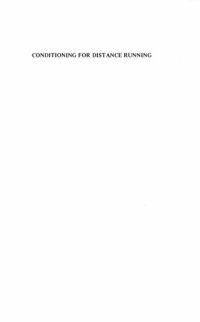
Ebook: Conditioning for Distance Running
- Series: American College of Sports Medicine Series
- Year: 1978
- Publisher: John Wiley & Sons
- City: New York, NY
- Language: English
- pdf
Our objective is to review the scientific knowledge pertinent to human performance and, particularly, to distance running. It is impossible to give a training prescription that fits all distance runners because the specifics of a program depend on each runner's weaknesses and strengths and the event for which each is training. However, the knowledge presented here will form the foundations on which each runner can develop his or her own ideal training program.
We begin by discussing the physiological systems that are of major importance in distance running-the neuromuscular, cardiovascular, and respiratory systems and their adaptation to endurance training. A detailed description of body metabolism, both oxidative (aerobic) and nonoxidative (anaerobic), is given. Then we consider environmental and nutritional factors. The section on training and running technique presents specific types of training that should be a part of every distance runner's program. The scientific rationale for the importance of the specific types of training is discussed. The most common injuries afflicting distance runners are described, and emphasis is placed on their prevention through daily stretching exercises. We conclude with a profile of the characteristics common to champion distance runners.
Keep in mind that many people run purely for enjoyment or fitness, with no intention of ever becoming competitive.
However, through greater participation, there will be a greater number of competitive distance runners. They come in all sizes, types, and ages, and proper knowledge can be gained and practiced only by an understanding of the basic systems involved and the principles on which reactions and adjustments to training and our environment are based.
Inaccuracies abound in athletics, and in an activity as popular and as potentially stressful as distance running, there is no room for misinformation directed toward either the jogger or the Olympic champion; both are equally deserving of proper guidance. We believe that this book contributes toward a better understanding of distance running.
We begin by discussing the physiological systems that are of major importance in distance running-the neuromuscular, cardiovascular, and respiratory systems and their adaptation to endurance training. A detailed description of body metabolism, both oxidative (aerobic) and nonoxidative (anaerobic), is given. Then we consider environmental and nutritional factors. The section on training and running technique presents specific types of training that should be a part of every distance runner's program. The scientific rationale for the importance of the specific types of training is discussed. The most common injuries afflicting distance runners are described, and emphasis is placed on their prevention through daily stretching exercises. We conclude with a profile of the characteristics common to champion distance runners.
Keep in mind that many people run purely for enjoyment or fitness, with no intention of ever becoming competitive.
However, through greater participation, there will be a greater number of competitive distance runners. They come in all sizes, types, and ages, and proper knowledge can be gained and practiced only by an understanding of the basic systems involved and the principles on which reactions and adjustments to training and our environment are based.
Inaccuracies abound in athletics, and in an activity as popular and as potentially stressful as distance running, there is no room for misinformation directed toward either the jogger or the Olympic champion; both are equally deserving of proper guidance. We believe that this book contributes toward a better understanding of distance running.
Download the book Conditioning for Distance Running for free or read online
Continue reading on any device:

Last viewed books
Related books
{related-news}
Comments (0)